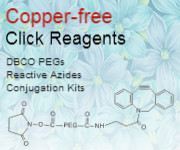Silane PEG Biotin
|
Synonym: Silane PEG Biotin, Biotin PEG Silane, Silane polyethylene glycol biotin, Biotin polyethylene glycol Silane
Description:
Ethoxy or methoxyl silane functionalized polyethylene glycol Biotin, silane PEG Biotin (Biotin-PEG-Si) is one of Nanocs surface reactive PEG derivatives that can be used to modify glass, silica and other surfaces via the reaction between hydroxyl group and ethoxyl/methoxyl silane. Biotin functional silane PEG is able to attached polyethylene glycol to various glass or metal surface biotin tag. Pegylation can greatly suppress the non-specific binding of charged molecules to the modified surfaces. And they have wide applications for medica device, biomems or biocompatible material development.
Physical Properties:
- Form: Solid
- Color: White
- Reactive group: Triethoxysilane
- Functional tag: Biotin
- Solubility: Soluble in water
- Purity: >95%
- Applications: Surface modification
Storage Conditions:
- Store at -20 0C. Desiccate. Silane PEG tends to hydrolyze from moisture. Avoid frequent thaw and frozen. USE ASAP.
Reaction Procedures:
Generally, silane PEG is first dissolved in a mixture of ethanol/water or DMSO solution, then allow the solution to contact with oxidized glass or silica surface for 30 min to 2 hours. Under this condition, silane PEG should bind to the material covalently.
Materials Required:
- Pegylation solution: Ethanol/water (w/w, 95%/5%);
- Silane PEG stock solution, 10~50 mg/mL in pegylation solution, prepare in fresh.
- Washing solution: Distilled water.
Reaction Steps:
- Dissolve targeted materials in Pegylation buffer.
- Add silane PEG stock solution to the targeted conjugation materials with the final concentration keep at least 10 mg/mL. 10~50 molar excess of silane PEG needed for optimal conjugation;
- Allow mixture agitates at room temperature for 30 min at room temperature or 2 hours at 4 -20 0C.
- Wash out unreacted materials either by distilled water.
References:
Click here to check hundreds of publications using Nanocs PEGs.



